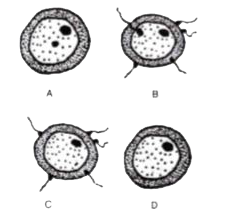Students were asked to observe the permanent slides showing different stages of budding in yeast under high-power of a microscope.
(i) Which adjustment screw were you asked to move to focus the slides?
(ii) Draw diagrams in correct sequence to show budding in yeast.
(i) Fine adjustment screws were moved to focus the slides.

Topper's Solved these Questions
- HOW DO ORGANISMS REPRODUCE ?BOOK - OSWAL PUBLICATIONCHAPTER - HOW DO ORGANISMS REPRODUCE ?EXERCISE - LONG ANSWER TYPE QUESTIONS
18 Videos
- HOW DO ORGANISMS REPRODUCE ?BOOK - OSWAL PUBLICATIONCHAPTER - HOW DO ORGANISMS REPRODUCE ?EXERCISE - DIAGRAM BASED QUESTIONS
14 Videos
- HOW DO ORGANISMS REPRODUCE ?BOOK - OSWAL PUBLICATIONCHAPTER - HOW DO ORGANISMS REPRODUCE ?EXERCISE - VERY SHORT ANSWER TYPE QUESTIONS
35 Videos
- HEREDITY AND EVOLUTION BOOK - OSWAL PUBLICATIONCHAPTER - HEREDITY AND EVOLUTION EXERCISE - CREATING BASED QUESTIONS
11 Videos
- LIFE PROCESSESBOOK - OSWAL PUBLICATIONCHAPTER - LIFE PROCESSESEXERCISE - BOARD CORNER (LONG ANSWER TYPE QUESTIONS)
2 Videos
Similar Questions
Students were asked to observe the permanent slides showing different stages of budding in yeast under high power of a microscope.
(a) Which adjustment screw (coarse/fine) were you asked to move to focus the slides?
(b) Draw three diagrams in correct sequence showing budding in yeast.
View SolutionStudents were asked to observe the permanent slides showing different stages of budding in yeast under high power of a microscope.
(a) Which adjustment screw (coarse/fine) were you asked to move to focus the slides?
(b) Draw three diagrams in correct sequence showing budding in yeast.
View Solution
Knowledge Check
In the slide showing binary fission in Amoeba and budding in yeast,the correct observations are:
Athe daughter cells of Amoeba and the bud of yeast are smaller than their respective parental cellsBthe daughter cells of Amoeba and the bud of yeast are smaller than their respective parental cellsCthe daughter cells of Amoeba are bigger than the parent but the bud of yeast is smaller than the parentDthe daughter cells of Amoeba are smaller than the parent but the bud of yeast is larger than the parent
Students were asked to observe the permanent slides showing different stage of
budding in yeast under high power of a microscope.
(a) Which adjustment scraw (coarse/fine) were you asked to move to foucs the slides?
(b) Draw three diagrams in correct sequence showing budding in yeast.
View SolutionIn the slides showing binary fission in Ameoba and budding in yeast, what is it observed?
View SolutionIn the slides showing binary fission in Ameoba and budding in yeast, what is it observed?
View SolutionA student is viewing under a microscope a permanent slide showing various stages of asexual reproduction by building in yeast. Draw diagrams of what he observes. (In proper sequence)
View SolutionA student is viewing under a microscope a permanent slide showing various stages of asexual reproduction by building in yeast. Draw diagrams of what he observes. (In proper sequence)
View SolutionA student is viewing under a microscope a permanent slide showing various stages of asexual reproduction by building in yeast. Draw diagrams of what he observes. (In proper sequence)
View SolutionGiven below are diagrams showing the different stages in the process of fertilisation of an egg in the human female reproductive tract.
Study the diagrams and answer the questions

(i) Arrange the letters given below each diagram in a logical sequence to show the correct order in the process of fertilisation.
(ii) Where does fertilisation normally take place? What is 'Implantation' that follows fertilisation ?
(iii) Mention the chromosome number of the egg and zygote in humans.
(iv) Explain the term 'Gestation'. How long does Gestation last in humans ?
(v) Draw a neat, labelled diagram of a mature human sperm.
View Solution
